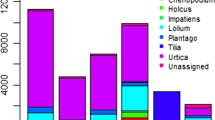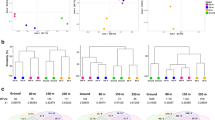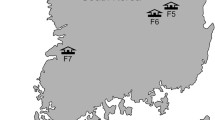Abstract
Despite the prevalence and costs of allergic diseases caused by pollen, we know little about the distributions of allergenic and non-allergenic pollen inside and outside homes at the continental scale. To better understand patterns in potential pollen diversity across the United States, we used DNA sequencing of a chloroplast marker gene to identify the plant DNA found in settled dust collected on indoor and outdoor surfaces across 459 homes. House location was the best predictor of the relative abundance of plant taxa found in outdoor dust samples. Urban, southern houses in hotter climates that were further from the coast were more likely to have more DNA from grass and moss species, while rural houses in northern, cooler climates closer to the coast were more likely to have higher relative abundances of DNA from Pinus and Cedrus species. In general, those plant taxa that were more abundant outdoors were also more abundant indoors, but indoor dust had uniquely high abundances of DNA from food plants and plants associated with lawns. Approximately 14 % of the plant DNA sequences found outside were from plant taxa that are known to have allergenic pollen compared to just 8 % inside. There was little geographic pattern in the total relative abundance of these allergens highlighting the difficulties associated with trying to predict allergen exposures based on geographic location alone. Together, this work demonstrates the utility of using environmental DNA sequencing to reconstruct the distributions of plant DNA inside and outside buildings, an approach that could prove useful for better understanding and predicting plant allergen exposures.



Similar content being viewed by others
References
Anderson, M. J. (2001). A new method for non-parametric multivariate analysis of variance. Austral Ecology, 26(1), 32–46.
Barberán, A., Dunn, R. R., Reich, B. J., Pacifici, K., Laber, E. B., Menninger, H. L., et al. (2015a). The ecology of microscopic life in household dust. Proceedings of the Royal Society B-Biological Sciences,. doi:10.1098/rspb.2015.1139.
Barberán, A., Ladau, J., Leff, J. W., Pollard, K. S., Menninger, H. L., Dunn, R. R., et al. (2015b). Continental-scale distributions of dust-associated bacteria and fungi. Proceedings of the National Academy of Science of the United States of America, 112(18), 5756–5761. doi:10.1073/pnas.1420815112.
Bruni, I., Galimberti, A., Caridi, L., Scaccabarozzi, D., De Mattia, F., Casiraghi, M., et al. (2015). A DNA barcoding approach to identify plant species in multiflower honey. Food Chemistry, 170, 308–315. doi:10.1016/j.foodchem.2014.08.060.
Burge, H. A. (2002). An update on pollen and fungal spore aerobiology. Journal of Allergy and Clinical Immunology, 110(4), 544–552. doi:10.1067/mai.2002.128674.
Campbell, I. D., McDonald, K., Flannigan, M. D., & Kringayark, J. (1999). Long-distance transport of pollen into the Arctic. Nature, 399(6731), 29–30.
Caporaso, J. G., Lauber, C. L., Walters, W. A., Berg-Lyons, D., Huntley, J., Fierer, N., et al. (2012). Ultra-high-throughput microbial community analysis on the Illumina HiSeq and MiSeq platforms. The ISME Journal, 6(8), 1621–1624.
Cecchi, L., Morabito, M., Domeneghetti, P., Crisci, A., Onorari, M., & Orlandini, S. (2006). Long distance transport of ragweed pollen as a potential cause of allergy in central Italy. Annals of Allergy, Asthma & Immunology, 96(1), 86–91.
D’Amato, G., Cecchi, L., Bonini, S., Nunes, C., Annesi-Maesano, I., Behrendt, H., et al. (2007). Allergenic pollen and pollen allergy in Europe. Allergy, 62(9), 976–990. doi:10.1111/j.1398-9995.2007.01393.x.
Denning, D., O’Driscoll, B., Hogaboam, C., Bowyer, P., & Niven, R. (2006). The link between fungi and severe asthma: A summary of the evidence. European Respiratory Journal, 27(3), 615–626.
Dufrêne, M., & Legendre, P. (1997). Species assemblages and indicator species: The need for a flexible asymmetrical approach. Ecological Monographs, 67(3), 345–366.
Dunwiddie, P. W. (1987). Macrofossil and pollen representation of coniferous trees in modern sediments from Washington. Ecology, 68(1), 1–11.
Edgar, R. C. (2010). Search and clustering orders of magnitude faster than BLAST. Bioinformatics, 26(19), 2460–2461.
Edgar, R. C. (2013). UPARSE: Highly accurate OTU sequences from microbial amplicon reads. Nature Methods, 10(10), 996–998.
Esch, R. E., Hartsell, C. J., Crenshaw, R., & Jacobson, R. S. (2001). Common allergenic pollens, fungi, animals, and arthropods. Clinical Reviews in Allergy and Immunology, 21(2), 261–292.
Fahlbusch, B., Hornung, D., Heinrich, J., Dahse, H. M., & Jäger, L. (2000). Quantification of group 5 grass pollen allergens in house dust. Clinical and Experimental Allergy, 30(11), 1646–1652.
Fahlbusch, B., Hornung, D., Heinrich, J., & Jäger, L. (2001). Predictors of group 5 grass-pollen allergens in settled house dust: Comparison between pollination and nonpollination seasons. Allergy, 56(11), 1081–1086. doi:10.1034/j.1398-9995.2001.00106.x.
Gavin, D. G., Brubaker, L. B., McLachlan, J. S., & Oswald, W. W. (2005). Correspondence of pollen assemblages with forest zones across steep environmental gradients, Olympic Peninsula, Washington, USA. The Holocene, 15(5), 648–662.
Grantham, N. S., Reich, B. J., Pacifici, K., Laber, E. B., Menninger, H. L., Henley, J. B., et al. (2015). Fungi identify the geographic origin of dust samples. PLoS One, 10(4), e0122605. doi:10.1371/journal.pone.0122605.
Heusser, C. J. (1978). Modern pollen rain of Washington. Canadian Journal of Botany, 56(13), 1510–1517.
Hjelmroos, M. (1991). Evidence of long-distance transport of Betula pollen. Grana, 30(1), 215–228.
Hugg, T., & Rantio-Lehtimäki, A. (2007). Indoor and outdoor pollen concentrations in private and public spaces during the Betula pollen season. Aerobiologia, 23(2), 119–129. doi:10.1007/s10453-007-9057-z.
Klepeis, N. E., Nelson, W. C., Ott, W. R., Robinson, J. P., Tsang, A. M., Switzer, P., et al. (2001). The National Human Activity Pattern Survey (NHAPS): A resource for assessing exposure to environmental pollutants. Journal of Exposure Analysis and Environmental Epidemiology, 11(3), 231–252.
Kress, W. J., Garcia-Robledo, C., Uriarte, M., & Erickson, D. L. (2015). DNA barcodes for ecology, evolution, and conservation. Trends in Ecology & Evolution, 30(1), 25–35. doi:10.1016/j.tree.2014.10.008.
Legendre, P., & Gallagher, E. D. (2001). Ecologically meaningful transformations for ordination of species data. Oecologia, 129(2), 271–280.
McLauchlan, K. K., Commerford, J. L., & Morris, C. J. (2013). Tallgrass prairie pollen assemblages in mid-continental North America. Vegetation History and Archaeobotany, 22(3), 171–183.
O’Rourke, M. K., & Lebowitz, M. D. (1984). A comparison of regional atmospheric pollen with pollen collected at and near homes. Grana, 23(1), 55–64.
Pawankar, R., Canonica, G. W., Holgate, S. T., & Lockey, R. F. (2012). Allergic diseases and asthma: A major global health concern. Current Opinion in Allergy and Clinical Immunology, 12(1), 39–41. doi:10.1097/ACI.0b013e32834ec13b.
Pichot, C., Calleja, M., Penel, V., Bues-Charbit, M., & Charpin, D. (2015). Inference of the pollen penetration and remanence into dwellings using seasonal variation of indoor/outdoor pollen counts. Aerobiologia, 31(3), 315–322. doi:10.1007/s10453-015-9366-6.
Richardson, R. T., Lin, C. H., Sponsler, D. B., Quijia, J. O., Goodell, K., & Johnson, R. M. (2015). Application of ITS2 metabarcoding to determine the provenance of pollen collected by honey bees in an agroecosystem. Applications in plant Sciences,. doi:10.3732/apps.1400066.
Rogers, C. A., & Levetin, E. (1998). Evidence of long-distance transport of mountain cedar pollen into Tulsa, Oklahoma. International Journal of Biometeorology, 42(2), 65–72.
Salvatori, N., Reccardini, F., Convento, M., Purinan, A., Colle, R., De Carli, S., et al. (2008). Asthma induced by inhalation of flour in adults with food allergy to wheat. Clinical and Experimental Allergy, 38(8), 1349–1356.
Sicherer, S. H., Furlong, T. J., DeSimone, J., & Sampson, H. A. (1999). Self-reported allergic reactions to peanut on commercial airliners. Journal of Allergy and Clinical Immunology, 104(1), 186–189.
Sterling, D. A., & Lewis, R. D. (1998). Pollen and fungal spores indoor and outdoor of mobile homes. Annals of Allergy, Asthma & Immunology, 80(3), 279–285.
Sugita, S. (1993). A model of pollen source area for an entire lake surface. Quaternary Research, 39(2), 239–244.
Taberlet, P., Coissac, E., Pompanon, F., Gielly, L., Miquel, C., Valentini, A., et al. (2007). Power and limitations of the chloroplast trnL (UAA) intron for plant DNA barcoding. Nucleic Acids Research, 35(3), e14. doi:10.1093/nar/gkl938.
Takahashi, Y., Takano, K., Suzuki, M., Nagai, S., Yokosuka, M., Takeshita, T., et al. (2008). Two routes for pollen entering indoors: Ventilation and clothes. Journal of Investigational Allergology and Clinical Immunology, 18, 382–388.
Taylor, P. E., Flagan, R. C., Valenta, R., & Glovsky, M. M. (2002). Release of allergens as respirable aerosols: A link between grass pollen and asthma. Journal of Allergy and Clinical Immunology, 109(1), 51–56.
WAO. (2011). World allergy organization white book on allergy. Milwaukee: World Allergy Organization.
Yoshimura, Y. (2011). Wind tunnel and field assessment of pollen dispersal in Soybean [Glycine max (L.) Merr.]. Journal of Plant Research, 124(1), 109–114.
Zavada, M. S., McGraw, S. M., & Miller, M. A. (2007). The role of clothing fabrics as passive pollen collectors in the north-eastern United States. Grana, 46(4), 285–291. doi:10.1080/00173130701780104.
Acknowledgments
We thank the volunteers who participated in the Wild Life of Our Homes project for collecting dust samples. Funding for the sample collection was provided by a grant from the A. P. Sloan Microbiology of the Built Environment Program (to NF and RRD).
Author information
Authors and Affiliations
Corresponding author
Appendix
Rights and permissions
About this article
Cite this article
Craine, J.M., Barberán, A., Lynch, R.C. et al. Molecular analysis of environmental plant DNA in house dust across the United States. Aerobiologia 33, 71–86 (2017). https://doi.org/10.1007/s10453-016-9451-5
Received:
Accepted:
Published:
Issue Date:
DOI: https://doi.org/10.1007/s10453-016-9451-5




